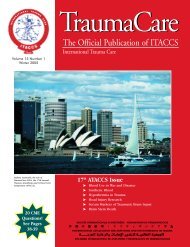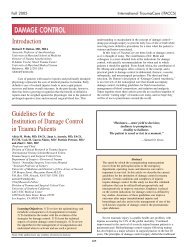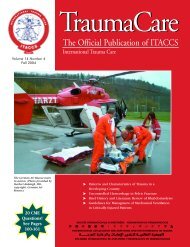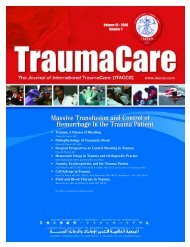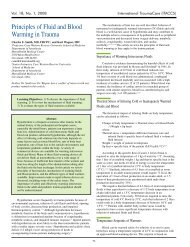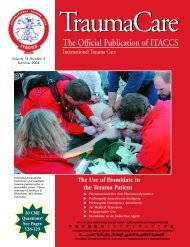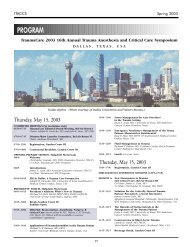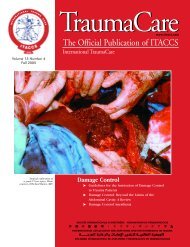ISO Cover Photos for TraumaCare - International Trauma ...
ISO Cover Photos for TraumaCare - International Trauma ...
ISO Cover Photos for TraumaCare - International Trauma ...
Create successful ePaper yourself
Turn your PDF publications into a flip-book with our unique Google optimized e-Paper software.
After high blood loss surgeries,patient outcomes can hangin the balance.The carrier in your plasma volume expander canaffect outcomes such as:• Coagulation difficulties.• Pain, including chest pain.• Use of anti-emetics.• Reduced renal output.Find out more with a call to your Abbott representativeor to 1-866-464-4261, extension HEXTEND (439-8363).®6% HETASTARCH IN LACTATED ELECTROLYTE INJECTION3-013-Mar., 03
• HEXTEND (6% Hetastarch in Lactated Electrolyte injection) is indicated in the treatment of hypovolemiawhen plasma volume expansion is desired. It is not a substitute <strong>for</strong> blood or plasma.• Solutions containing hetastarch are contraindicated in patients with known sensitivity to hydroxyethylstarch, bleeding disorders or with congestive heart failure where volume overload is a potential problem.• Solutions containing hetastarch should not be used in renal disease with oliguria or anuria not relatedto hypovolemia.Please see brief summary of Prescribing In<strong>for</strong>mation on following page.
BRIEF SUMMARYa HEXTEND ®6% Hetastarch in Lactated Electrolyte InjectionFlexible Plastic ContainerINDICATIONS AND USAGEHEXTEND (6% Hetastarch in Lactated Electrolyte Injection) is indicated in the treatment of hypovolemiawhen plasma volume expansion is desired. It is not a substitute <strong>for</strong> blood or plasma.CONTRAINDICATIONSSolutions containing hetastarch are contraindicated in patients with known hypersensitivity tohydroxyethyl starch or with bleeding disorders or with congestive heart failure where volume overloadis a potential problem. Solutions containing hetastarch should not be used in renal disease with oliguriaor anuria not related to hypovolemia.Solutions containing lactate are NOT FOR USE IN THE TREATMENT OF LACTIC ACIDOSIS.WARNINGSSolutions containing calcium should not be administered simultaneously with blood through the sameadministration set because of the likelihood of coagulation.Life threatening anaphylactic/anaphylactoid reactions have been rarely reported with solutionscontaining hetastarch; death has occurred, but a causal relationship has not been established.Patients who develop severe anaphylactic/anaphylactoid reactions may need continued supportivecare until symptoms have resolved.Hypersensitivity reactions can occur even after solutions containing hetastarch have beendiscontinued.Solutions which contain potassium should be used with great care, if at all, in patients withhyperkalemia and severe renal failure and in situations in which potassium retention is present.Solutions containing sodium ions should be used with great care, if at all, in patients with congestiveheart failure and severe renal insufficiency and in clinical states in which edema with sodium retentionoccurs.In patients with diminished renal function,administration of solutions containing sodium orpotassium ions may result in sodium or potassiumretention.Solutions containing lactate ions should be used withgreat care in patients with metabolic or respiratoryalkalosis. The administration of lactate ions should beper<strong>for</strong>med with great care when dealing with conditions inwhich an increased level or an impaired utilization ofthese ions occurs, such as severe hepatic insufficiency.DO NOT USE IN LEUKAPHERESIS.Usage in Plasma Volume ExpansionLarge volumes of isotonic solutions containing 6%hetastarch (HEXTEND or Hetastarch Injection) maytransiently alter the coagulation mechanism due tohemodilution and a mild direct inhibitory action on FactorVIII. Hemodilution by isotonic solutions containing 6%hetastarch may also result in a 24 hour decline of totalprotein, albumin, and fibrinogen levels and in transientprolongation of prothrombin, activated partialthromboplastin, clotting, and bleeding times.Hematocrit may be decreased and plasma proteinsdiluted excessively by administration of large volumes ofisotonic solutions containing 6% hetastarch.Administration of packed red cells, platelets, and freshfrozen plasma should be considered if excessive dilutionoccurs.In randomized, controlled, comparative studies of Hetastarch Injection (n = 92) and Albumin (n = 85)in surgical patients, no patient in either treatment group had a bleeding complication and no significantdifference was found in the amount of blood loss between the treatment groups.HEXTEND has not been adequately evaluated to establish its safety in situations other than treatmentof hypovolemia in elective surgery. In some cases, the use of isotonic solutions containing 6%hetastarch has been associated with coagulation abnormalities in conjunction with an acquired,reversible von Willebrand’s-like syndrome and/or Factor VIII deficiency when used over a period ofdays. Replacement therapy should be considered if a severe Factor VIII or von Willebrand deficiency isidentified. If a coagulopathy develops, it may take several days to resolve. Certain conditions may affectthe safe use of isotonic solutions containing 6% hetastarch on a chronic basis. For example, in patientswith subarachnoid hemorrhage where an isotonic solution containing 6% hetastarch is used repeatedlyover a period of days <strong>for</strong> the prevention of cerebral vasospasm, significant clinical bleeding may occur.Intracranial bleeding resulting in death has been reported with the use of Hetastarch Injection.PRECAUTIONSGeneralThe possibility of circulatory overload should be kept in mind. Caution should be used when the risk ofpulmonary edema and/or congestive heart failure is increased. Special care should be exercised inpatients who have impaired renal clearance since this is the principal way in which hetastarch iseliminated and in clinical states in which edema with sodium retention occurs.Indirect bilirubin levels of 8.3 mg/L (normal 0.0-7.0 mg/L) have been reported in 2 out of 20 normalsubjects who received multiple infusions of Hetastarch Injection. Total bilirubin was within normallimits at all times; indirect bilirubin returned to normal by 96 hours following the final infusion. Thesignificance, if any, of these elevations is not known; however, caution should be observed be<strong>for</strong>eadministering isotonic solutions containing 6% hetastarch to patients with a history of liver disease.If a hypersensitivity effect occurs, administration of the drug should be discontinued and appropriatetreatment and supportive measures should be undertaken (see WARNINGS).Caution should be used when administering solutions containing hetastarch to patients allergic tocorn because such patients can also be allergic to hetastarch.Clinical evaluation and periodic laboratory determinations are necessary to monitor changes in fluidbalance, electrolyte concentrations, acid-base balance, and coagulation parameters during prolongedparenteral therapy or whenever the condition of the patient warrants such evaluation.Solutions containing dextrose should be used with caution in patients with known subclinical orovert diabetes mellitus.Caution must be exercised in the administration of parenteral fluids, especially those containing6% HETASTARCH IN LACTATED ELECTROLYTE INJECTIONsodium ions, to patients receiving corticosteroids or corticotropin.Potassium containing solutions should be used with caution in the presence of cardiac disease,particularly in digitalized patients or in the presence of renal disease.Solutions containing lactate ions should be used with caution as excess administration may result inmetabolic alkalosis.Elevated serum amylase levels may be observed temporarily following administration ofsolutions containing hetastarch although no association with pancreatitis has beendemonstrated. Serum amylase levels cannot be used to assess or to evaluate <strong>for</strong> pancreatitis<strong>for</strong> 3-5 days after administration of solutions containing hetastarch. Elevated serum amylaselevels persist <strong>for</strong> longer periods of time in patients with renal impairment. Solutions containinghetastarch have not been shown to increase serum lipase.One report suggests that in the presence of renal glomerular damage, larger molecules of hetastarchcan leak into the urine and elevate the specific gravity. The elevation of specific gravity can obscurethe diagnosis of renal failure.Hetastarch is not eliminated by hemodialysis. The utility of other extracorporeal eliminationtechniques has not been evaluated.If administration is by pressure infusion, all air should be withdrawn or expelled from the bag throughthe medication port prior to infusion.Carcinogenesis, Mutagenesis, Impairment of FertilityLong-term studies of animals have not been per<strong>for</strong>med to evaluate the carcinogenic potential ofhetastarch.Teratogenic Effects: Pregnancy Category C.Hetastarch Injection has been shown to have an embryocidal effect on New Zealand rabbits whengiven intravenously over the entire organogenesis period in a daily dose 1/2 times the maximumrecommended therapeutic human dose (1500 mL) and on BD rats when given intraperitoneally, from the16th to the 21st day of pregnancy, in a daily dose 2.3 times the maximum recommended therapeutichuman dose. When Hetastarch Injection was administered to New Zealand rabbits, BD rats, and Swissmice with intravenous daily doses of 2 times, 1/3 times, and 1 times the maximum recommendedtherapeutic human dose, respectively, over several days during the period of gestation, no evidence ofteratogenicity was evident. There are no adequate and well controlled studies in pregnant women.HEXTEND should be used during pregnancy only if the potential benefit justifies the potential risk to thefetus.Nursing MothersIt is not known whether hetastarch is excreted in human milk. Because many drugs are excreted inhuman milk, caution should be exercised when HEXTEND is administered to a nursing woman.Pediatric UseThe safety and effectiveness of HEXTEND in pediatricpatients have not been established. Adequate, wellcontrolledclinical trials to establish the safety andeffectiveness of HEXTEND in pediatric patients have notbeen conducted. However, in one small double-blindstudy, 47 infants, children, and adolescents (ages 1 yearto 15.5 years) scheduled <strong>for</strong> repair of congenital heartdisease with moderate hypothermia were randomized toreceive either Hetastarch Injection or Albumin as apostoperative volume expander during the first 24 hoursafter surgery. Thirty-eight children required colloidreplacement therapy, of which 20 children receivedHetastarch Injection. No differences were found in thecoagulation parameters or in the amount of replacementfluids required in the children receiving 20 mL/kg or lessof either colloid replacement therapy. In children whoreceived greater than 20 mL/kg of Hetastarch Injection,®an increase in prothrombin time was demonstrated (p =0.006). There were no neonates included in this study.Geriatric UseOf the total number of patients in clinical trials ofHEXTEND (n=119), 30% were 65 or older while 12% were70 or older. Other reported experience with HetastarchInjection has not identified differences in responsesbetween elderly and younger patients, but greatersensitivity of some older individuals cannot be ruled out.This drug is known to be substantially excreted by thekidney, and the risk of toxic reactions to this drug may be greater in patients with impaired renalfunction. Because elderly patients are more likely to have decreased renal function, care should betaken in dose selection, and it may be useful to monitor renal function.ADVERSE REACTIONSIn clinical trials comparing the plasma volume expanding properties of HEXTEND (n=60) with those ofHetastarch Injection (n=59), there were no significant differences in the number of adverse or seriousadverse events between the two groups.Reported adverse reactions with isotonic solutions containing 6% hetastarch include:GeneralHypersensitivity (see WARNINGS).Death, life-threatening anaphylactic/anaphylactoid reactions, cardiac arrest, ventricular fibrillation,severe hypotension, non-cardiac pulmonary edema, laryngeal edema, bronchospasm, angioedema,wheezing, restlessness, tachypnea, stridor, fever, chest pain, bradycardia, tachycardia, shortness ofbreath, chills, urticaria, pruritus, facial and periorbital edema, coughing, sneezing, flushing, erythemamulti<strong>for</strong>me, and rash.CardiovascularCirculatory overload, congestive heart failure, and pulmonary edema (see PRECAUTIONS).HematologicIntracranial bleeding, bleeding and/or anemia due to hemodilution (see WARNINGS) and/or Factor VIIIdeficiency, acquired von Willebrand’s-like syndrome, and coagulopathy including rare cases ofdisseminated intravascular coagulopathy and hemolysis. With extensive clinical use of HetastarchInjection, rare cases of disseminated intravascular coagulopathy and hemolysis have been observed.MetabolicMetabolic acidosis.OtherVomiting, peripheral edema of the lower extremities, submaxillary and parotid glandular enlargement,mild influenza-like symptoms, headaches, and muscle pains. Hydroxyethyl starch-associated pruritushas been reported in some patients with deposits of hydroxyethyl starch in peripheral nerves.Caution: Federal (USA) law prohibits dispensing without prescription.©Abbott 1999 Reference 58-0851-R2-Rev. September, 1999 Printed in USAManufactured and Distributed by: Abbott Laboratories, North Chicago, IL 60064, USAUnder license from BioTime, Inc., Berkeley, CA 94710, USA36
**For infections due to susceptible strainsof indicated organisms.Careful inquiry should be madeconcerning previous hypersensitivityreaction, as serious and occasionallyfatal anaphylactic reactions have beenreported in patients receiving therapywith penicillins. ZOSYN is contraindicatedin patients with a history of thesereactions to any of the penicillins,cephalosporins, or ß-lactamase inhibitors.While ZOSYN possesses the characteristiclow toxicity of the penicillin group ofantibiotics, periodic assessment of organsystem functions, including renal, hepatic,and hematopoietic, during prolongedtherapy is advisable.During clinical trials, pseudomembranouscolitis has been rarely reported (
ZOSYN ® (Piperacillin and Tazobactam <strong>for</strong> Injection) Brief SummarySee package insert <strong>for</strong> full prescribing in<strong>for</strong>mation.CONTRAINDICATIONS ZOSYN is contraindicated in patients with a history of allergic reactions to any of thepenicillins, cephalosporins, or β-lactamase inhibitors.WARNINGS SERIOUS AND OCCASIONALLY FATAL HYPERSENSITIVITY (ANAPHYLACTIC/ANAPHYLACTOID)REACTIONS (INCLUDING SHOCK) HAVE BEEN REPORTED IN PATIENTS RECEIVING THERAPY WITHPENICILLINS INCLUDING ZOSYN. THESE REACTIONS ARE MORE LIKELY TO OCCUR IN INDIVIDUALS WITHA HISTORY OF PENICILLIN HYPERSENSITIVITY OR A HISTORY OF SENSITIVITY TO MULTIPLE ALLERGENS.THERE HAVE BEEN REPORTS OF INDIVIDUALS WITH A HISTORY OF PENICILLIN HYPERSENSITIVITY WHOHAVE EXPERIENCED SEVERE REACTIONS WHEN TREATED WITH CEPHALOSPORINS. BEFORE INITIATINGTHERAPY WITH ZOSYN, CAREFUL INQUIRY SHOULD BE MADE CONCERNING PREVIOUS HYPERSENSITIVITYREACTIONS TO PENICILLINS, CEPHALOSPORINS, OR OTHER ALLERGENS. IF AN ALLERGIC REACTIONOCCURS, ZOSYN SHOULD BE DISCONTINUED AND APPROPRIATE THERAPY INSTITUTED. SERIOUSANAPHYLACTIC/ANAPHYLACTOID REACTIONS (INCLUDING SHOCK) REQUIRE IMMEDIATE EMERGENCYTREATMENT WITH EPINEPHRINE. OXYGEN, INTRAVENOUS STEROIDS, AND AIRWAY MANAGEMENT,INCLUDING INTUBATION, SHOULD ALSO BE ADMINISTERED AS INDICATED.Pseudomembranous colitis has been reported with nearly all antibacterial agents, including ZOSYN,and may range in severity from mild to life-threatening. Consider this diagnosis in patients whopresent with diarrhea after antibacterial agent administration. Treatment with antibacterial agents altersthe normal flora of the colon and may permit overgrowth of clostridia. Studies indicate that a toxinproduced by Clostridium difficile is one primary cause of “antibiotic-associated colitis.”After the diagnosis of pseudomembranous colitis has been established, initiate therapeutic measures. Mildcases usually respond to drug discontinuation alone. In moderate to severe cases, fluids and electrolytes,protein supplementation, and treatment with an antibacterial drug clinically effective against Clostridiumdifficile colitis may be necessary.PRECAUTIONS General: Bleeding manifestations have occurred in some patients receiving β-lactam antibiotics,including piperacillin. These reactions have sometimes been associated with coagulation test abnormalitiessuch as clotting time, platelet aggregation, and prothrombin time and are more likely to occur in renal failurepatients. If bleeding manifestations occur, discontinue ZOSYN and institute appropriate therapy.The possibility of the emergence of resistant organisms that might cause superinfections should be kept inmind. If this occurs, appropriate measures should be taken.As with other penicillins, patients may experience neuromuscular excitability or convulsions if higher thanrecommended doses are given intravenously (particularly in the presence of renal failure).ZOSYN is a monosodium salt of piperacillin and a monosodium salt of tazobactam, containing 2.35 mEq(54 mg) of Na+ per gram of piperacillin; consider this when treating patients requiring restricted salt intake.Per<strong>for</strong>m periodic electrolyte determinations in patients with low potassium reserves; the possibility ofhypokalemia should be kept in mind with patients who have potentially low potassium reserves and whoare receiving cytotoxic therapy or diuretics.As with other semisynthetic penicillins, piperacillin has been associated with an increased incidence offever and rash in cystic fibrosis patients.In patients with renal insufficiency or in hemodialysis patients, the intravenous dose should be adjusted to thedegree of renal function impairment. (See Full Prescribing In<strong>for</strong>mation—DOSAGE AND ADMINISTRATION.)Laboratory Tests: Per<strong>for</strong>m periodic assessment of hematopoietic function, especially with prolongedtherapy, ie, ≥21 days. (See ADVERSE REACTIONS—Adverse Laboratory Events.)Drug Interactions: Aminoglycosides —The mixing of ZOSYN with an aminoglycoside in vitro can result insubstantial inactivation of the aminoglycoside. (See Full Prescribing In<strong>for</strong>mation—DOSAGE ANDADMINISTRATION—Compatible Intravenous Diluent Solutions.)When ZOSYN was co-administered with tobramycin, the area under the curve, renal clearance, and urinaryrecovery of tobramycin were decreased by 11%, 32%, and 38%, respectively. Pharmacokinetic alterationsof tobramycin when administered with ZOSYN may be due to in vivo and in vitro inactivation of tobramycinin the presence of piperacillin/tazobactam. The inactivation of aminoglycosides in the presence of penicillinclassdrugs has been recognized. It has been postulated that microbiologically inactive penicillinaminoglycosidecomplexes of unknown toxicity <strong>for</strong>m. In patients with severe renal dysfunction (ie, chronichemodialysis patients), tobramycin pharmacokinetics are significantly altered when administered withpiperacillin. The alteration of tobramycin pharmacokinetics and the potential toxicity of the penicillinaminoglycosidecomplexes in patients with mild to moderate renal dysfunction who are administered anaminoglycoside with ZOSYN are unknown.Probenecid—Probenecid administered with ZOSYN prolongs the half-life of piperacillin by 21% and oftazobactam by 71%.Vancomycin—No pharmacokinetic interactions with ZOSYN have been noted.Heparin—Coagulation parameters should be tested more frequently and monitored regularly duringsimultaneous administration of high doses of heparin, oral anticoagulants, or other drugs that may affectthe blood coagulation system or the thrombocyte function.Vecuronium—Piperacillin used with vecuronium has been implicated in the prolongation of the neuromuscularblockade of vecuronium. ZOSYN could produce the same phenomenon if given with vecuronium. Due to theirsimilar mechanism of action, the neuromuscular blockade produced by any of the non-depolarizing musclerelaxants could be prolonged in the presence of piperacillin. (See package insert <strong>for</strong> vecuronium bromide.)Methotrexate—Piperacillin may reduce the excretion of methotrexate; there<strong>for</strong>e, serum levels of methotrexateshould be monitored in patients to avoid drug toxicity.Drug/Laboratory Test Interactions: As with other penicillins, ZOSYN may result in a false-positive reaction<strong>for</strong> glucose in the urine using a copper-reduction method (CLINITEST ®§ ). Glucose tests based on enzymaticglucose oxidase reactions (such as DIASTIX ®§ or TES-TAPE ®§ ) are recommended.Carcinogenesis, Mutagenesis, Impairment of Fertility: Long term carcinogenicity studies in animals havenot been conducted with piperacillin/tazobactam, piperacillin, or tazobactam. Piperacillin/tazobactam wasnegative in the following mutagenicity tests/assays up to the concentrations noted: microbial mutagenicityassay (14.84/1.86 µg/plate), unscheduled DNA synthesis (UDS) test (5689/711 µg/mL), mammalian pointmutation (Chinese hamster ovary cell HPRT) assay (8000/1000 µg/mL), and a mammalian cell (BALB/c-3T3)trans<strong>for</strong>mation assay (8/1 µg/mL). In vivo, piperacillin/tazobactam did not induce chromosomal aberrationsin rats dosed I.V. with 1500/187.5 mg/kg; this dose is similar to the maximum recommended human daily(MRHD) dose on a body-surface-area basis (BSA) (mg/m 2 ).Piperacillin was negative in the following mutagenicity tests/assays up to the concentrations noted: microbialmutagenicity assays (50 µg/plate), UDS test (10,000 µg/mL), and a cell (BALB/c-3T3) trans<strong>for</strong>mation assay(3000 µg/mL). There was no DNA damage in bacteria (Rec assay) exposed to piperacillin at concentrationsup to 200 µg/disk. In a mammalian point mutation (mouse lymphoma cells) assay, piperacillin was positiveat concentrations ≥2500 µg/mL. In vivo, piperacillin did not induce chromosomal aberrations in mice at I.V.doses up to 2000 mg/kg/day or rats at I.V. doses up to 1500 mg/kg/day. These doses are half (mice) orsimilar to (rats) the MRHD dose based on BSA (mg/m 2 ). In another in vivo test, there was no dominantlethal effect when piperacillin was administered to rats at I.V. doses up to 2000 mg/kg/day, which is similarto the MRHD dose based on BSA (mg/m 2 ). When mice were administered piperacillin at I.V. doses up to2000 mg/kg/day, which is half the MRHD dose based on BSA (mg/m 2 ), urine from these animals was notmutagenic when tested in a microbial mutagenicity assay. Bacteria injected into the peritoneal cavity of miceadministered piperacillin at I.V. doses up to 2000 mg/kg/day did not show increased mutation frequencies.Tazobactam was negative in the following mutagenicity assays up to the concentrations noted: microbialmutagenicity assays (333 µg/plate), UDS test (2000 µg/mL), mammalian point mutation (Chinese hamsterovary cell HPRT) (5000 µg/mL), a cell (BALB/c-3T3) trans<strong>for</strong>mation assay (900 µg/mL). In anothermammalian point mutation (mouse lymphoma cells) assay, tazobactam was positive at concentrations≥3000 µg/mL. In an in vitro cytogenetics (Chinese hamster lung cells) assay, tazobactam was negative atconcentrations up to 3000 µg/mL. In vivo, tazobactam did not induce chromosomal aberrations in rats atI.V. doses up to 5000 mg/kg, which is 23 times the MRHD dose based on BSA (mg/m 2 ).Pregnancy: Teratogenic effects—Pregnancy Category B: Piperacillin/tazobactam: Reproduction studies inrats have revealed no evidence of impaired fertility due to piperacillin/tazobactam administered up to a dosewhich is similar to the MRHD dose based on BSA (mg/m 2 ).Teratology studies in mice and rats have revealed no evidence of harm to the fetus due to piperacillin/tazobactam administered up to a dose which is 1 to 2 times and 2 to 3 times the human dose ofpiperacillin and tazobactam, respectively, based on BSA (mg/m 2 ). Piperacillin and tazobactam cross theplacenta in humans.Piperacillin: Reproduction and teratology studies in mice and rats have revealed no evidence of impairedfertility or fetal harm due to piperacillin administered up to a dose which is half (mice) or similar to (rats)the MRHD dose based on BSA (mg/m 2 ).Tazobactam: Reproduction studies in rats have revealed no evidence of impaired fertility due to tazobactamadministered at doses up to 3 times the MRHD dose based on BSA (mg/m 2 ).Teratology studies in mice and rats have revealed no evidence of fetal harm due to tazobactam administered atdoses up to 6 and 14 times, respectively, the human dose based on BSA (mg/m 2 ). In rats, tazobactam crossesthe placenta. Concentrations in the fetus are less than or equal to 10% of those found in maternal plasma.There are no adequate and well-controlled studies with the piperacillin/tazobactam combination or withpiperacillin or tazobactam alone in pregnant women. Use this drug during pregnancy only if clearly needed.Nursing Mothers: Piperacillin is excreted in low concentrations in human milk; tazobactam concentrationsin human milk have not been studied. Exercise caution when ZOSYN is administered to a nursing woman.Pediatric Use: Safety and efficacy in pediatric patients have not been established.Geriatric Use: Patients over 65 years are not at an increased risk of developing adverse effects solelybecause of age. However, dosage should be adjusted in the presence of renal insufficiency. The geriatricpopulation may respond with a blunted natriuresis to salt loading. This may be clinically importantwith regard to such diseases as congestive heart failure. Because elderly patients are more likely tohave decreased renal function, care should be taken in dose selection, and it may be useful to monitorrenal function. (See Full Prescribing In<strong>for</strong>mation—DOSAGE AND ADMINISTRATION.)ADVERSE REACTIONS During the initial clinical investigations, 2621 patients worldwide were treated withZOSYN in phase 3 trials. In the key North American clinical trials (n=830 patients), 90% of the adverseevents reported were mild to moderate in severity and transient in nature. However, in 3.2% of the patientstreated worldwide, ZOSYN was discontinued because of adverse events primarily involving the skin (1.3%),including rash and pruritus; the gastrointestinal system (0.9%), including diarrhea, nausea, and vomiting;and allergic reactions (0.5%).Adverse local reactions that were reported, irrespective of relationship to ZOSYN therapy, were phlebitis (1.3%),injection site reaction (0.5%), pain (0.2%), inflammation (0.2%), thrombophlebitis (0.2%), and edema (0.1%).Adverse Clinical Events: Based on patients from the North American trials (n=1063), the events with thehighest incidence in patients, irrespective of relationship to ZOSYN therapy, were diarrhea (11.3%);headache (7.7%); constipation (7.7%); nausea (6.9%); insomnia (6.6%); rash (4.2%), includingmaculopapular, bullous, urticarial, and eczematoid; vomiting (3.3%); dyspepsia (3.3%); pruritus (3.1%);stool changes (2.4%); fever (2.4%); agitation (2.1%); pain (1.7%); moniliasis (1.6%); hypertension (1.6%);dizziness (1.4%); abdominal pain (1.3%); chest pain (1.3%); edema (1.2%); anxiety (1.2%); rhinitis (1.2%);and dyspnea (1.1%).Additional adverse systemic clinical events reported in 1.0% or less of the patients in the initial NorthAmerican trials are listed below within each body system. Autonomic nervous system—hypotension,ileus, syncope. Body as a whole—rigors, back pain, malaise. Cardiovascular—tachycardia, includingsupraventricular and ventricular; bradycardia; arrhythmia, including atrial fibrillation, ventricularfibrillation, cardiac arrest, cardiac failure, circulatory failure, myocardial infarction. Central nervoussystem—tremor, convulsions, vertigo. Gastrointestinal—melena, flatulence, hemorrhage, gastritis,hiccough, ulcerative stomatitis. Pseudomembranous colitis was reported in one patient during theclinical trials. The onset of pseudomembranous colitis symptoms may occur during or after antibacterialtreatment. (See Warnings.) Hearing and Vestibular System—tinnitus. Hypersensitivity—anaphylaxis.Metabolic and Nutritional—symptomatic hypoglycemia, thirst. Musculoskeletal—myalgia, arthralgia.Platelets, Bleeding, Clotting—mesenteric embolism, purpura, epistaxis, pulmonary embolism (SeePrecautions, General). Psychiatric—confusion, hallucination, depression. Reproductive, Female—leukorrhea, vaginitis. Respiratory—pharyngitis, pulmonary edema, bronchospasm, coughing. Skinand Appendages—genital pruritus, diaphoresis. Special senses—taste perversion. Urinary—retention,dysuria, oliguria, hematuria, incontinence. Vision—photophobia. Vascular (extracardiac)—flushing.In a completed study of nosocomial lower respiratory tract infections, 222 patients were treated with ZOSYNin a dosing regimen of 4.5 g every 6 hours in combination with an aminoglycoside and 215 patients weretreated with imipenem/cilastatin (500 mg/500 mg q6h) in combination with an aminoglycoside. Twenty-five(25, 11.0%) patients in the piperacillin/tazobactam group and 14 (6.5%) in the imipenem/cilastatin group(p > 0.05) discontinued treatment due to an adverse event. Adverse events that occurred in more than 1%of patients and were considered by the investigator to be drug-related were: diarrhea (17.6%), fever(2.7%), vomiting (2.7%), urinary tract infection (2.7%), rash (2.3%), abdominal pain (1.8%), generalizededema (1.8%), moniliasis (1.8%), nausea (1.8%), oral moniliasis (1.8%), BUN increased (1.8%), creatinineincreased (1.8%), peripheral edema (1.8%), abdomen enlarged (1.4%), headache (1.4%), constipation (1.4%),liver function tests abnormal (1.4%), thrombocythemia (1.4%), excoriations (1.4%), and sweating (1.4%).Drug-related adverse events reported in 1% or less of patients in the nosocomial pneumonia study ofZOSYN with an aminoglycoside were: acidosis, acute kidney failure, agitation, alkaline phosphataseincreased, anemia, asthenia, atrial fibrillation, chest pain, CNS depression, colitis, confusion, convulsion,cough increased, thrombocytopenia, dehydration, depression, diplopia, drug level decreased, dry mouth,dyspepsia, dysphagia, dyspnea, dysuria, eosinophilia, fungal dermatitis, gastritis, glossitis, grand malconvulsion, hematuria, hyperglycemia, hypernatremia, hypertension, hypertonia, hyperventilation,hypochromic anemia, hypoglycemia, hypokalemia, hyponatremia, hypophosphatemia, hypoxia, ileus,injection site edema, injection site pain, injection site reaction, kidney function abnormal, leukocytosis,leukopenia, local reaction to procedure, melena, pain, prothrombin decreased, pruritus, respiratorydisorder, SGOT increased, SGPT increased, sinus bradycardia, somnolence, stomatitis, stupor, tremor,tachycardia, ventricular extrasystoles, and ventricular tachycardia.In a previous nosocomial pneumonia study conducted with a dosing regimen of 3.375 g given every 4 hourswith an aminoglycoside, the following adverse events, irrespective of drug relationship, were observed:diarrhea (20%); constipation (8.4%); agitation (7.1%); nausea (5.8%); headache (4.5%); insomnia (4.5%);oral thrush (3.9%); erythematous rash (3.9%); anxiety (3.2%); fever (3.2%); pain (3.2%); pruritus (3.2%);hiccough (2.6%); vomiting (2.6%); dyspepsia (1.9%); edema (1.9%); fluid overload (1.9%); stool changes(1.9%); anorexia (1.3%); cardiac arrest (1.3%); confusion (1.3%); diaphoresis (1.3%); duodenal ulcer (1.3%);flatulence (1.3%); hypertension (1.3%); hypotension (1.3%); inflammation at injection site (1.3%); pleuraleffusion (1.3%); pneumothorax (1.3%); rash, not otherwise specified (1.3%); supraventricular tachycardia(1.3%); thrombophlebitis (1.3%); and urinary incontinence (1.3%).Adverse events irrespective of drug relationship observed in 1% or less of patients in the above studywith ZOSYN and an aminoglycoside included: aggressive reaction (combative), angina, asthenia, atelectasis,balanoposthitis, cerebrovascular accident, chest pain, conjunctivitis, deafness, dyspnea, earache, ecchymosis,fecal incontinence, gastric ulcer, gout, hemoptysis, hypoxia, pancreatitis, perineal irritation/pain, urinarytract infection with trichomonas, vitamin B12 deficiency anemia, xerosis, and yeast in urine.Additional adverse events reported from worldwide marketing experience with ZOSYN, where causalrelationship to ZOSYN is uncertain: Gastrointestinal: hepatitis, cholestatic jaundice. Hematologic: hemolyticanemia, anemia, thrombocytosis, agranulocytosis, pancytopenia. Immune: hypersensitivity reactions,anaphylactic/anaphylactoid reactions (including shock). Infections: candidal superinfections. Renal:interstitial nephritis, renal failure. Skin and Appendages: erythema multi<strong>for</strong>me and Stevens-Johnsonsyndrome; toxic epidermal necrolysis.Adverse Laboratory Events (Seen During Clinical Trials): Of the studies reported, including that ofnosocomial lower respiratory tract infections in which a higher dose of ZOSYN was used in combinationwith an aminoglycoside, changes in laboratory parameters, without regard to drug relationship, include:Hematologic: decreases in hemoglobin and hematocrit, thrombocytopenia, increases in platelet count,eosinophilia, leukopenia, neutropenia. The leukopenia/neutropenia appears to be reversible and mostfrequently associated with prolonged administration, ie, ≥21 days of therapy. These patients were withdrawnfrom therapy; some had accompanying systemic symptoms (eg, fever, rigors, chills). Coagulation: positivedirect Coombs’ test, prolonged prothrombin time, prolonged partial thromboplastin time. Hepatic: transientelevations of AST (SGOT), ALT (SGPT), alkaline phosphatase, bilirubin. Renal: increases in serum creatinine,blood urea nitrogen. Urinalysis: proteinuria, hematuria, pyuria.Additional laboratory events include abnormalities in electrolytes (ie, increases and decreases in sodium,potassium, and calcium), hyperglycemia, decreases in total protein or albumin, blood glucose decreased,gamma-glutamyltransferase increased, hypokalemia, and bleeding time prolonged.The following adverse reaction has also been reported <strong>for</strong> PIPRACIL ® (sterile piperacillin sodium): Skeletal:prolonged muscle relaxation. (See PRECAUTIONS—Drug Interactions.)Piperacillin therapy has been associated with an increased incidence of fever and rash in cystic fibrosis patients.OVERDOSAGE There have been post-marketing reports of overdose with piperacillin/tazobactam. Themajority of those events experienced including nausea, vomiting, and diarrhea have also been reported withthe usual recommended dosages. Patients may experience neuromuscular excitability or convulsions ifhigher than recommended doses are given intravenously (particularly in the presence of renal failure).Treatment should be supportive and symptomatic according to the patient's clinical presentation. Excessiveserum concentrations of either piperacillin or tazobactam may be reduced by hemodialysis. (See FullPrescribing In<strong>for</strong>mation—CLINICAL PHARMACOLOGY.)§CLINITEST ® and DIASTIX ® are registered trademarks of Ames Division, Miles Laboratories, Inc.§TES-TAPE ® is a registered trademark of Eli Lilly and Company.This Brief Summary is based on ZOSYN direction circular CI 7876-1 (Revised April 2003).© © 2003, Wyeth Pharmaceuticals, Philadelphia, PA PA 19101 105023-01
ITACCS Winter 2004<strong>ISO</strong> <strong>Cover</strong> <strong>Photos</strong> <strong>for</strong> <strong><strong>Trauma</strong>Care</strong>Send Us Your <strong>Photos</strong> <strong>for</strong> the <strong>Cover</strong> of <strong><strong>Trauma</strong>Care</strong>:Prehospital care scenes (rescues or drills)Busy clinical settings • Emergency vehicles in motionHealth care teams in actionSUMMER 2002 Obtain written permission from identifiable people.FALL 2002Photographers will be given credit <strong>for</strong> prints published in <strong><strong>Trauma</strong>Care</strong>.Send to Managing Editor, <strong><strong>Trauma</strong>Care</strong>, P.O. Box 4826, Baltimore, MD 21211 USA or <strong><strong>Trauma</strong>Care</strong>Mail@aol.com.Join the worldwide revolution in trauma care!JOIN ITACCS!Membership Form:Name:____________________________________________■ MD ■ DO ■ PhD ■ CRNA ■ RN ■ CCRN■ Other(s) _______________________________________Mailing Address: ___________________________________City/State:_________________________________________Zip/Country Code: _________________________________Country:__________________________________________Hospital Affiliation: ________________________________Academic/Clinical Position: _________________________Telephone Number:________________________________Fax Number: ______________________________________E-mail Address: ____________________________________Membership Category:■ Corporate Member (US$1000)■ Full Member (US$100)■ Professional in Training (US$40) (a letter verifyingtraining status is required)Method of Payment:■ US Check (US residents only) - Make checkpayable to ITACCS.■ <strong>International</strong> Draft - Make payable to ITACCSthrough a US bank in US dollars.■ Bank Transfer - Must be written in US dollars.Verification of transfer from financial institutionmust accompany this <strong>for</strong>m. Please have fundstransferred to ITACCS Account Number 169-8133-3with First National Bank of Maryland, RouteNumber 052000113.■ Credit Card: ■ MasterCard ■ VISACard No.: _____________________________________Expiration Date: _______________________________Name as it appears on card:__________________________________________________Signature:_________________________________________Return membership <strong>for</strong>m and dues toITACCS World Headquarters,PO Box 4826, Baltimore MD 21211 USAEditorial Board <strong>for</strong> <strong><strong>Trauma</strong>Care</strong>Editor-in-ChiefJohn K. Stene, MD, PhD (USA)Associate EditorCalvin Johnson, MD (USA)Pediatric <strong>Trauma</strong>Gail E. Rasmussen, MD (USA)James E. Fletcher, MD, MBBS (USA)Thomas J. Long, MD (USA)Prehospital CareDario Gonzalez, MD, FACEP (USA)David Lacombe, NREMT-P (USA)Herbert Kuhnigk, MD (Germany)Hans Morten Lossius, MD (Norway)Eldar Søreide, MD, PhD (Norway)Associate EditorRichard P. Dutton, MD (USA)Emergency Department CareBruce Adams, MD (USA)Dale M. Carrison, DO, FACEP (USA)Ludi Jagminas, MD (USA)Marvin Wayne, MD, FACEP (USA)Educational ObjectivesOR and Intensive CareJames G. Cain, MD (USA)William F. Fallon, Jr., MD, FACS (USA)Maureen McCunn, MD (USA)Charles E. Smith, MD, FRCPC (USA)Associate EditorAlfred C. Pinchak, MD (USA)ResearchTo be namedCRNA SectionCharles R. Barton, MEd, CRNA (USA)James M. Rich, MA, CRNA (USA)<strong>International</strong> Advisory BoardWolfgang F. Dick, MD, PhD (Germany)Christopher M. Grande, MD, MPH (USA)Louis M. Guzzi, MD (USA)Yves Lambert, MD (France)Walter Mauritz, MD, PhD (Austria)Jerry Nolan, MB, ChB, FFARCS (England)Michael J.A. Parr, MB, BS, MRCP(UK),FRCA (Australia)Anne J. Sutcliffe, FRCA (England)Keiichi Tanaka, MD (Japan)This publication/activity is designed to providetrauma care professionals interested in the treatment ofcritically ill trauma patients with a regular overview andcritical analysis of the most current, clinically usefulin<strong>for</strong>mation available, covering strategies and advances inthe diagnosis of traumatic injuries and the treatment oftrauma patients. Controversies, advantages, anddisadvantages of diagnosis and treatment plans areemphasized. There are no prerequisites <strong>for</strong> participationin this activity.After reading each issue, participants should have aworking familiarity with the most significant in<strong>for</strong>mationand perspectives presented and apply what they havelearned promptly in clinical practice. Specific learningobjectives are listed at the opening of each article.39



